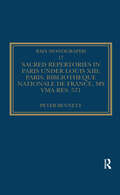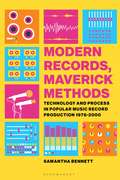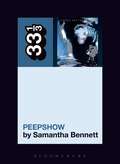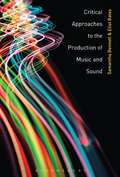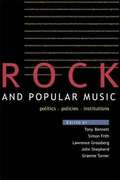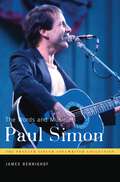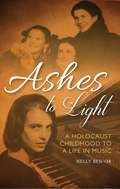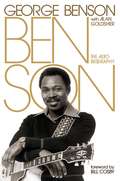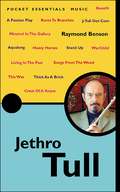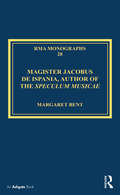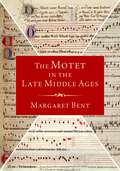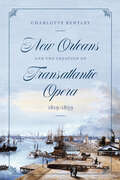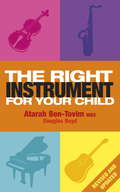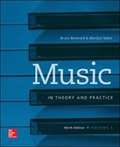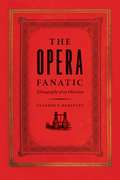- Table View
- List View
Sacred Repertories in Paris under Louis XIII: Paris, Bibliothèque nationale de France, MS Vma rés. 571
by Peter BennettThe study of sacred music under Louis XIII (r.1610-43) has advanced little in the past hundred years. Despite some important recent contributions by the late Denise Launay and others, much of our current perception of the Latin sacred music of the period is still informed by the pioneering research undertaken by Henri Quittard in the early years of the twentieth century. Even with Quittard’s work, however, the almost complete absence of surviving sources has severely limited our understanding of this era. But by re-examining one of the seventeenth-century ’treasures’ of the Bibliothèque nationale (MS Vma rés. 571), Sacred Repertories in Paris under Louis XIII reveals that, far from being a transitional period in which little music of any interest was produced, the reign of Louis XIII witnessed a flowering of musical activity and the development of musical techniques normally associated with the reign of Louis XIV. Based on an exhaustive and innovative manuscript study, Sacred Repertories shows that Vma rés. 571 (a largely anonymous source of previously unknown provenance) was copied in Paris by the composer André Pechon, and that it preserves three previously unidentified repertories with connections to the court of Louis XIII. The repertoire of the musique de la chambre, until now considered a secular institution, shows it to have been an equal partner of the chapelle in the provision of sacred music at court. The repertoire of the royal parish church of Saint-Germain-l’Auxerrois, the only ’working’ liturgical repertory surviving from the century, illustrates musical practices at this important collegiate church. And the repertoire of the Royal Benedictine Abbey of Montmartre testifies to the richness of musical tradition in Parisian convents during a period when no other comparable music from France survives. Sacred Repertories thus transforms our understanding of the musical landscape of seventeenth-century France and provides a springboard fo
Modern Records, Maverick Methods: Technology and Process in Popular Music Record Production 1978-2000
by Samantha BennettFrom the Fairlight CMI through MIDI to the digital audio workstations at the turn of the millennium, Modern Records, Maverick Methods examines a critical period in commercial popular music record production: the transformative digital age from the late 1970s until 2000. Drawing on a discography of more than 300 recordings across pop, rock, hip hop, dance and alternative musics from artists such as the Beastie Boys, Madonna, U2 and Fatboy Slim, and extensive and exclusive ethnographic work with many world-renowned recordists, Modern Records presents a fresh and insightful new perspective on one of the most significant eras in commercial music record production.The book traces the development of significant music technologies through the 1980s and 1990s, revealing how changing attitudes and innovative techniques of recording personnel reimagined recording processes and, finally, exemplifies the impact of these technologies and techniques via six comprehensive tech-processual analyses. This meticulously researched and timely book reveals the complexity of recordists' responses to a technological landscape in flux.
Modern Records, Maverick Methods: Technology and Process in Popular Music Record Production 1978-2000
by Samantha BennettFrom the Fairlight CMI through MIDI to the digital audio workstations at the turn of the millennium, Modern Records, Maverick Methods examines a critical period in commercial popular music record production: the transformative digital age from the late 1970s until 2000. Drawing on a discography of more than 300 recordings across pop, rock, hip hop, dance and alternative musics from artists such as the Beastie Boys, Madonna, U2 and Fatboy Slim, and extensive and exclusive ethnographic work with many world-renowned recordists, Modern Records presents a fresh and insightful new perspective on one of the most significant eras in commercial music record production.The book traces the development of significant music technologies through the 1980s and 1990s, revealing how changing attitudes and innovative techniques of recording personnel reimagined recording processes and, finally, exemplifies the impact of these technologies and techniques via six comprehensive tech-processual analyses. This meticulously researched and timely book reveals the complexity of recordists' responses to a technological landscape in flux.
Siouxsie and the Banshees' Peepshow (33 1/3)
by Samantha BennettIn 1978, Siouxsie and the Banshees declared 'We don't see ourselves in the same context as other rock'n'roll bands.' A decade later, and in the stark aftermath of a devastating storm, the band retreated to a 17th-century mansion house in the deracinated Sussex countryside to write their ninth studio album, Peepshow. Here, the band absorbed the bygone, rural atmosphere and its inspirational mise en scène, thus framing the record cinematically, as Siouxsie Sioux recalled, 'It was as if we were doing the whole thing on the set of The Wicker Man'.Samantha Bennett looks at how Siouxsie and the Banshees' Peepshow is better understood in the context of film and film music (as opposed to popular music studies or, indeed, the works of other rock'n'roll bands). Drawing upon more than one hundred films and film scores, this book focuses on Peepshow's deeply embedded historical and aesthetic (para)cinematic influences: How is each track a reflection of genre film? Who are the various featured protagonists? And how does Peepshow's diverse orchestration, complex musical forms, atypical narratives and evocative soundscapes reveal an inherently cinematic record? Ultimately, Peepshow can be read as a soundtrack to all the films Siouxsie and the Banshees ever saw. Or perhaps it was the soundtrack to the greatest film they never made.
Siouxsie and the Banshees' Peepshow (33 1/3 #132)
by Samantha BennettIn 1978, Siouxsie and the Banshees declared 'We don't see ourselves in the same context as other rock'n'roll bands.' A decade later, and in the stark aftermath of a devastating storm, the band retreated to a 17th-century mansion house in the deracinated Sussex countryside to write their ninth studio album, Peepshow. Here, the band absorbed the bygone, rural atmosphere and its inspirational mise en scène, thus framing the record cinematically, as Siouxsie Sioux recalled, 'It was as if we were doing the whole thing on the set of The Wicker Man'.Samantha Bennett looks at how Siouxsie and the Banshees' Peepshow is better understood in the context of film and film music (as opposed to popular music studies or, indeed, the works of other rock'n'roll bands). Drawing upon more than one hundred films and film scores, this book focuses on Peepshow's deeply embedded historical and aesthetic (para)cinematic influences: How is each track a reflection of genre film? Who are the various featured protagonists? And how does Peepshow's diverse orchestration, complex musical forms, atypical narratives and evocative soundscapes reveal an inherently cinematic record? Ultimately, Peepshow can be read as a soundtrack to all the films Siouxsie and the Banshees ever saw. Or perhaps it was the soundtrack to the greatest film they never made.
Critical Approaches to the Production of Music and Sound
by Samantha Bennett Eliot BatesWho produces sound and music? And in what spaces, localities and contexts? As the production of sound and music in the 21st Century converges with multimedia, these questions are critically addressed in this new edited collection by Samantha Bennett and Eliot Bates. Critical Approaches to the Production of Music and Sound features 16 brand new articles by leading thinkers from the fields of music, audio engineering, anthropology and media. Innovative and timely, this collection represents scholars from around the world, revisiting established themes such as record production and the construction of genre with new perspectives, as well as exploring issues in cultural and virtual production.
Critical Approaches to the Production of Music and Sound
by Samantha Bennett Eliot BatesWho produces sound and music? And in what spaces, localities and contexts? As the production of sound and music in the 21st Century converges with multimedia, these questions are critically addressed in this new edited collection by Samantha Bennett and Eliot Bates. Critical Approaches to the Production of Music and Sound features 16 brand new articles by leading thinkers from the fields of music, audio engineering, anthropology and media. Innovative and timely, this collection represents scholars from around the world, revisiting established themes such as record production and the construction of genre with new perspectives, as well as exploring issues in cultural and virtual production.
Rock And Popular Music: Politics, Policies, Institutions (Culture: Policy and Politics Ser.)
by Tony Bennett Lawrence Grossberg Shepherd Frith Simon Larry Grossberg Simon Frith John Shepherd Graeme TurnerRock and Popular Music examines the relations between the policies and institutions which regulate contemporary popular music and the political debates, contradictions and struggles in which those musics are involved. International in its scope and conception, this innovative collection explores the reasons for and ways in which governments have sought either to support or prohibit popular music in Canada, Australia and Europe as well as the impact of broadcasting policies in forming and shaping different musical communities. Rock and Popular Music is a unique collection suggesting significant new directions for the study of contemporary popular musics.
Rock and Popular Music: Politics, Policies, Institutions (Culture: Policy and Politics Ser. #(PDF))
by Tony Bennett Lawrence Grossberg Shepherd Frith Simon Larry Grossberg Simon Frith John Shepherd Graeme TurnerRock and Popular Music examines the relations between the policies and institutions which regulate contemporary popular music and the political debates, contradictions and struggles in which those musics are involved. International in its scope and conception, this innovative collection explores the reasons for and ways in which governments have sought either to support or prohibit popular music in Canada, Australia and Europe as well as the impact of broadcasting policies in forming and shaping different musical communities. Rock and Popular Music is a unique collection suggesting significant new directions for the study of contemporary popular musics.
The Words and Music of Paul Simon (The Praeger Singer-Songwriter Collection)
by James BennighofPaul Simon is commonly acknowledged to be one of the most successful singer-songwriters of the pop-rock era. His work has flourished in the context of Simon and Garfunkel as well as in his own solo career. Starting with the folk-rock style that marked his earliest significant success, he has drawn on a wide variety of influences, including many American traditions and, later, many international ones as well. He has won multiple Grammy awards in both the duo and the solo phases of his career. His songwriting has also provided the impetus for brief forays into film and musical theatre. After providing a brief biographical overview, this work examines Simon's songwriting work in depth, providing a critical discussion of each song as a fusion of text and music so as to help the reader to identify elements that enhance appreciation.A particularly valuable contribution in this context is the discussion of the wide variety of musical elements that contribute significantly to the value of Simon's work. These include such easily-understandable issues as verse-chorus structure, melodic variation, selection of particular instruments and even performers, variation of musical style within a song, general harmonic characteristics, relationships among keys, rhythm and pacing of text, etc. While the book proceeds chronologically through Simon's recorded output, specific threads are developed throughout, and the discussion of individual songs takes place in the context of these threads, both drawing on them and developing them further. The diversity of Paul Simon's work reflects his very American background, and no discussion of American music is complete without accounting for his influence.
Ashes to Light: A Holocaust Childhood to a Life in Music
by Nelly Ben-OrBorn into a Jewish family in Lvov, Poland in the early-1930s, Nelly Ben-Or was to experience, at a very young age, the trauma of the Holocaust. This narrative of her life's journey describes the miraculous survival of Nelly, her mother and her older sister. With help from family and friends, Nelly and her mother were smuggled out of the Ghetto in Lvov and escaped to Warsaw with false identity papers where they were under constant threat of discovery as Jews were sent to concentration camps and murdered. They then survived being taken on a train to Auschwitz, not, in fact, because they were Jews, but as citizens of Warsaw following the Warsaw Uprising against the Nazis. No less miraculous was how her innate musical talent survived and was even occasionally able to reveal itself, during these Holocaust years. After the war, they were reunited with Nelly's sister, who had remained in hiding in Lvov.
Benson: The Autobiography (Piano-vocal-guitar Ser.)
by George Benson Alan GoldsherOver the course of his fifty-year career, George Benson has performed for hundreds of millions of fans around the world, received ten Grammy Awards, and recorded with some of the most revered musicians of his era. In 2011, he earned a National Endowment of the Arts Jazz Masters Award. And he has finally decided to tell his story.Benson: The Autobiography follows the musician's remarkable rise from the ghettos of Pittsburgh to the stages of Dubai, and everywhere in between. His tales of scuffling on the road with jazz legend Brother Jack McDuff, navigating his way through the recording studio with Miles Davis, and emerging as the first true (and truly successful) jazz/soul crossover artist will enthrall devotees of both music history and pop culture.An open and truthful raconteur, Benson discusses his near-arrest for domestic abuse, the tragic illnesses that afflicted his family, the secret lives of his musical cohorts, and racism's effect on his life and art. His long-awaited book allows readers to meet one of the most beloved, prolific, and bestselling musicians of any era.
Benson: The Autobiography
by George Benson Alan GoldsherOver the course of his fifty-year career, George Benson has performed for hundreds of millions of fans around the world, received ten Grammy Awards, and recorded with some of the most revered musicians of his era. In 2011, he earned a National Endowment of the Arts Jazz Masters Award. And he has finally decided to tell his story.Benson: The Autobiography follows the musician's remarkable rise from the ghettos of Pittsburgh to the stages of Dubai, and everywhere in between. His tales of scuffling on the road with jazz legend Brother Jack McDuff, navigating his way through the recording studio with Miles Davis, and emerging as the first true (and truly successful) jazz/soul crossover artist will enthrall devotees of both music history and pop culture.An open and truthful raconteur, Benson discusses his near-arrest for domestic abuse, the tragic illnesses that afflicted his family, the secret lives of his musical cohorts, and racism's effect on his life and art. His long-awaited book allows readers to meet one of the most beloved, prolific, and bestselling musicians of any era.
Jethro Tull: The Pocket Essential Guide (Pocket Essential Ser.)
by Raymond BensonThe Legendary Jethro Tull - How many rock bands from the sixties can you name that are still around today? Probably not that many. There are a couple — the Rolling Stones, Santana-but most have broken up, stopped recording, and reappear only for the ubiquitous 'reunion' tours. Jethro Tull is one band that formed in 1968 and are still going strong, thanks to the leadership, vision, and extraordinary talent of its leader, Ian Anderson. Named after the 17th Century inventor of the seed drill, Jethro Tull have always been controversial, challenging, and completely impossible to categorize. Are they rock? Blues? 'Progressive'? English folk? These labels merely begin to describe Jethro Tull's eclectic and imaginative music. Author Raymond Benson looks at this legendary rock band and analyzes their place in pop music history. He examines every Jethro Tull album—track listing, personnel, cover art, recording history, and content. A handy rating system informs Tull newbies where to start and provides longtime fans with fodder for debate. A book for both the casual and hard-core fan, Jethro Tull is an insightful companion to enhance one's listening pleasure.
Magister Jacobus de Ispania, Author of the Speculum musicae (Royal Musical Association Monographs)
by Margaret BentThe Speculum musicae of the early fourteenth century, with nearly half a million words, is by a long way the largest medieval treatise on music, and probably the most learned. Only the final two books are about music as commonly understood: the other five invite further work by students of scholastic philosophy, theology and mathematics. For nearly a century, its author has been known as Jacques de Liège or Jacobus Leodiensis. ’Jacobus’ is certain, fixed by an acrostic declared within the text; Liège is hypothetical, based on evidence shown here to be less than secure. The one complete manuscript, Paris BnF lat. 7207, thought by its editor to be Florentine, can now be shown on the basis of its miniatures by Cristoforo Cortese to be from the Veneto, datable c. 1434-40. New documentary evidence in an Italian inventory, also from the Veneto, describes a lost copy of the treatise dating from before 1419, older than the surviving manuscript, and identifies its author as ’Magister Jacobus de Ispania’. If this had been known eighty years ago, the Liège hypothesis would never have taken root. It invites a new look at the geography and influences that played into this central document of medieval music theory. The two new attributes of ’Magister’ and ’de Ispania’ (i.e. a foreigner) prompted an extensive search in published indexes for possible identities. Surprisingly few candidates of this name emerged, and only one in the right date range. It is here suggested that the author of the Speculum is either someone who left no paper trail or James of Spain, a nephew of Eleanor of Castile, wife of King Edward I, whose career is documented mostly in England. He was an illegitimate son of Eleanor’s older half-brother, the Infante Enrique of Castile. Documentary evidence shows that he was a wealthy and well-travelled royal prince who was also an Oxford magister. The book traces his career and the likelihood of his authorship of the Speculum musicae.
Magister Jacobus de Ispania, Author of the Speculum musicae (Royal Musical Association Monographs)
by Margaret BentThe Speculum musicae of the early fourteenth century, with nearly half a million words, is by a long way the largest medieval treatise on music, and probably the most learned. Only the final two books are about music as commonly understood: the other five invite further work by students of scholastic philosophy, theology and mathematics. For nearly a century, its author has been known as Jacques de Liège or Jacobus Leodiensis. ’Jacobus’ is certain, fixed by an acrostic declared within the text; Liège is hypothetical, based on evidence shown here to be less than secure. The one complete manuscript, Paris BnF lat. 7207, thought by its editor to be Florentine, can now be shown on the basis of its miniatures by Cristoforo Cortese to be from the Veneto, datable c. 1434-40. New documentary evidence in an Italian inventory, also from the Veneto, describes a lost copy of the treatise dating from before 1419, older than the surviving manuscript, and identifies its author as ’Magister Jacobus de Ispania’. If this had been known eighty years ago, the Liège hypothesis would never have taken root. It invites a new look at the geography and influences that played into this central document of medieval music theory. The two new attributes of ’Magister’ and ’de Ispania’ (i.e. a foreigner) prompted an extensive search in published indexes for possible identities. Surprisingly few candidates of this name emerged, and only one in the right date range. It is here suggested that the author of the Speculum is either someone who left no paper trail or James of Spain, a nephew of Eleanor of Castile, wife of King Edward I, whose career is documented mostly in England. He was an illegitimate son of Eleanor’s older half-brother, the Infante Enrique of Castile. Documentary evidence shows that he was a wealthy and well-travelled royal prince who was also an Oxford magister. The book traces his career and the likelihood of his authorship of the Speculum musicae.
The Motet in the Late Middle Ages
by Margaret BentA unique capacity of measured polyphony is to give precisely fixed places not only to musical notes, but also to individual words in relation to them and each other. The Motet in the Late Middle Ages offers innovative approaches to the equal partnership of music and texts in motets of the fourteenth century and beyond, showcasing the imaginative opportunities afforded by this literal kind of intertextuality, and yielding a very different narrative from the common complaint that different simultaneous texts make motets incomprehensible. As leading musicologist Margaret Bent asserts, they simply require a different approach to preparation and listening. In this book, Bent examines the words and music of motets from many different angles: foundational verbal quotations and pre-existent chant excerpts and their contexts, citations both of words and music from other compositions, function, dating, structure, theory, and number symbolism. Individual studies of these original creations tease out a range of strategies, ingenuity, playfulness, striking juxtapositions, and even subversion. Half of the thirty-two chapters consist of new material; the other half are substantially revised and updated versions of previously published articles and chapters, organized into seven Parts. With new analyses of text and music together, new datings, new attributions, and new hypotheses about origins and interrelationships, Bent uncovers little-explored dimensions, provides a window into the craft and thought processes of medieval composers, and opens up many directions for future work.
The Motet in the Late Middle Ages
by Margaret BentA unique capacity of measured polyphony is to give precisely fixed places not only to musical notes, but also to individual words in relation to them and each other. The Motet in the Late Middle Ages offers innovative approaches to the equal partnership of music and texts in motets of the fourteenth century and beyond, showcasing the imaginative opportunities afforded by this literal kind of intertextuality, and yielding a very different narrative from the common complaint that different simultaneous texts make motets incomprehensible. As leading musicologist Margaret Bent asserts, they simply require a different approach to preparation and listening. In this book, Bent examines the words and music of motets from many different angles: foundational verbal quotations and pre-existent chant excerpts and their contexts, citations both of words and music from other compositions, function, dating, structure, theory, and number symbolism. Individual studies of these original creations tease out a range of strategies, ingenuity, playfulness, striking juxtapositions, and even subversion. Half of the thirty-two chapters consist of new material; the other half are substantially revised and updated versions of previously published articles and chapters, organized into seven Parts. With new analyses of text and music together, new datings, new attributions, and new hypotheses about origins and interrelationships, Bent uncovers little-explored dimensions, provides a window into the craft and thought processes of medieval composers, and opens up many directions for future work.
The Motet in the Late Middle Ages
by Margaret BentA unique capacity of measured polyphony is to give precisely fixed places not only to musical notes, but also to individual words in relation to them and each other. The Motet in the Late Middle Ages offers innovative approaches to the equal partnership of music and texts in motets of the fourteenth century and beyond, showcasing the imaginative opportunities afforded by this literal kind of intertextuality, and yielding a very different narrative from the common complaint that different simultaneous texts make motets incomprehensible. As leading musicologist Margaret Bent asserts, they simply require a different approach to preparation and listening. In this book, Bent examines the words and music of motets from many different angles: foundational verbal quotations and pre-existent chant excerpts and their contexts, citations both of words and music from other compositions, function, dating, structure, theory, and number symbolism. Individual studies of these original creations tease out a range of strategies, ingenuity, playfulness, striking juxtapositions, and even subversion. Half of the thirty-two chapters consist of new material; the other half are substantially revised and updated versions of previously published articles and chapters, organized into seven Parts. With new analyses of text and music together, new datings, new attributions, and new hypotheses about origins and interrelationships, Bent uncovers little-explored dimensions, provides a window into the craft and thought processes of medieval composers, and opens up many directions for future work.
New Orleans and the Creation of Transatlantic Opera, 1819–1859 (Opera Lab: Explorations in History, Technology, and Performance)
by Charlotte BentleyA history of nineteenth-century New Orleans and the people who made it a vital, if unexpected, part of an emerging operatic world. New Orleans and the Creation of Transatlantic Opera, 1819–1859 explores the thriving operatic life of New Orleans in the first half of the nineteenth century, drawing out the transatlantic connections that animated it. By focusing on a variety of individuals, their extended webs of human contacts, and the materials that they moved along with them, this book pieces together what it took to bring opera to New Orleans and the ways in which the city’s operatic life shaped contemporary perceptions of global interconnection. The early chapters explore the process of bringing opera to the stage, taking a detailed look at the management of New Orleans’s Francophone theater, the Théâtre d’Orléans, as well as the performers who came to the city and the reception they received. But opera’s significance was not confined to the theater, and later chapters of the book examine how opera permeated everyday life in New Orleans, through popular sheet music, novels, magazines and visual culture, and dancing in its many ballrooms. Just as New Orleans helped to create transatlantic opera, opera in turn helped to create the city of New Orleans.
The Right Instrument For Your Child: The Key To Unlocking Musical Potential
by Atarah Ben-Tovim Douglas BoydThis unique book offers a simple and practical method of selecting the right instrument for the individual child.Starting with the physical and emotional make-up of the child and using questionnaires and charts, the authors systematically explain the pros and cons of various instruments. For instance, a child who loves company might not enjoy playing the piano as it is predominantly a solo instrument. It appeals more to quiet introverts and yet many a child has been forced to learn only to give up as soon as they are allowed. As well as examining each individual instrument, the authors give advice on how some of the pitfalls can be avoided and provide information on buying and practising. Based on years of research by the authors, whose experience is unsurpassed, this is a comprehensive and inspirational book that will help unlock every child's potential.
Music In Theory And Practice Volume 1 (PDF)
by Bruce Benward Marilyn SakerThis best-selling text gives music majors and minors a solid foundation in the theory of music. It strengthens their musical intuition, builds technical skills, and helps them gain interpretive insights. The goal of the text is to instruct readers on the practical application of knowledge. The analytical techniques presented are carefully designed to be clear, uncomplicated, and readily applicable to any repertoire. The two-volume format ensures exhaustive coverage and maximum support for students and faculty alike. Volume I serves as a general introduction to music theory while Volume II offers a survey of the theoretical underpinnings of musical styles and forms from Gregorian Chant through the present day. The supplemental instructor's materials provide clear-cut solutions to assignment materials. Music in Theory and Practice is a well-rounded textbook that integrates the various components of musical structure and makes them accessible to students at the undergraduate level.
The Opera Fanatic: Ethnography of an Obsession
by Claudio E. BenzecryThough some dismiss opera as old-fashioned, it shows no sign of disappearing from the world’s stage. So why do audiences continue to flock to it? Given its association with wealth, one might imagine that opera tickets function as a status symbol. But while a desire to hobnob with the upper crust might motivate the occasional operagoer, for hardcore fans the real answer, according to The Opera Fanatic, is passion—they do it for love. Opera lovers are an intense lot, Claudio E. Benzecry discovers in his look at the fanatics who haunt the legendary Colón Opera House in Buenos Aires, a key site for opera’s globalization. Listening to the fans and their stories, Benzecry hears of two-hundred-mile trips for performances and nightlong camp-outs for tickets, while others testify to a particular opera’s power to move them—whether to song or to tears—no matter how many times they have seen it before. Drawing on his insightful analysis of these acts of love, Benzecry proposes new ways of thinking about people’s relationship to art and shows how, far from merely enhancing aspects of everyday life, art allows us to transcend it.
The Opera Fanatic: Ethnography of an Obsession
by Claudio E. BenzecryThough some dismiss opera as old-fashioned, it shows no sign of disappearing from the world’s stage. So why do audiences continue to flock to it? Given its association with wealth, one might imagine that opera tickets function as a status symbol. But while a desire to hobnob with the upper crust might motivate the occasional operagoer, for hardcore fans the real answer, according to The Opera Fanatic, is passion—they do it for love. Opera lovers are an intense lot, Claudio E. Benzecry discovers in his look at the fanatics who haunt the legendary Colón Opera House in Buenos Aires, a key site for opera’s globalization. Listening to the fans and their stories, Benzecry hears of two-hundred-mile trips for performances and nightlong camp-outs for tickets, while others testify to a particular opera’s power to move them—whether to song or to tears—no matter how many times they have seen it before. Drawing on his insightful analysis of these acts of love, Benzecry proposes new ways of thinking about people’s relationship to art and shows how, far from merely enhancing aspects of everyday life, art allows us to transcend it.
The Opera Fanatic: Ethnography of an Obsession
by Claudio E. BenzecryThough some dismiss opera as old-fashioned, it shows no sign of disappearing from the world’s stage. So why do audiences continue to flock to it? Given its association with wealth, one might imagine that opera tickets function as a status symbol. But while a desire to hobnob with the upper crust might motivate the occasional operagoer, for hardcore fans the real answer, according to The Opera Fanatic, is passion—they do it for love. Opera lovers are an intense lot, Claudio E. Benzecry discovers in his look at the fanatics who haunt the legendary Colón Opera House in Buenos Aires, a key site for opera’s globalization. Listening to the fans and their stories, Benzecry hears of two-hundred-mile trips for performances and nightlong camp-outs for tickets, while others testify to a particular opera’s power to move them—whether to song or to tears—no matter how many times they have seen it before. Drawing on his insightful analysis of these acts of love, Benzecry proposes new ways of thinking about people’s relationship to art and shows how, far from merely enhancing aspects of everyday life, art allows us to transcend it.
